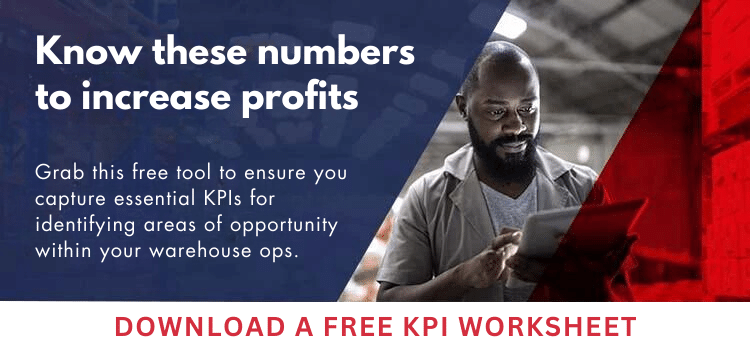Planning and executing the move of a new ecommerce fulfillment center is a massive undertaking. Budgeting of one-time costs, start-up costs and on-going expenses is rigorous. This article demonstrates how we would approach a warehouse move, and as an example, how we collaborated with a client to develop their budget for opening a new facility and operating two facilities during the transition period.
In our blog How to Develop A Plan to Move Your Fulfillment Center, we outlined at a high-level six task categories to consider. Detailed budgeting was one task. Let’s take a look at what we recommend for budgeting for moving your warehouse.
Select the new location
The first step in a warehouse move is to select the location. Consider factors like available space that’s suitable for your operation, labor costs, etc.
One recent client’s first choice was to stay locally -- a major metro area -- to retain the current management and fulfillment staff. In reality, though, there were no facilities within a 100-mile radius that were large enough to include expansion to 100,000 SF. New space will cost 25% less than current square footage costs.
Their site studies showed current warehouse labor costs were a minimum of $3.00 per hour higher than smaller cities surveyed. The company made a tough decision to move fulfillment to a smaller city 350 miles away (a six hour drive), where quality labor was more available at a significantly lower cost. This move means that an all-new management team and fulfillment staff had to be recruited.
Plan by month
Warehouse moves of larger facilities typically take six to 12 months from the time the lease is signed.
The detail line item budget was projected by month from lease signing through the shut-down of the existing facility. This approach gave management visibility to the incremental increase in expenses for personnel, purchasing equipment, deposits due, and overlapping transition costs for two facilities.
Expense planning considerations
We recommend the following considerations during your budgeting process:
- Personnel budget
Develop a detailed personnel budget for the transition. Consider the costs to hire new staff, retention bonuses for staff that stays on, etc.
Our client has 75 total staff members including management and leads. Because of the distance from headquarters, one of the major considerations was hiring a capable and experienced Director of Operations that could be trusted to manage the facility with minimal senior management involvement. Salary databases for the selected market showed both Warehouse and Distribution Center Managers earn $50,000 to $125,000 plus bonus and benefits, obviously indicating a big difference in experience and skills. The client decided on a salary of $90,000 (75th percentile) plus bonus and benefits.
The client developed the personnel budget at the detail level by job title, hours worked annually and wage rates. If applicable, performance bonus, severance costs and retention bonuses were included to complete transition (retention bonuses were used to incentivize existing employees to work the transition period). - Recruitment and training budget
By job title, plan the number of new hires by week. Recognize the need to hire more employees initially to end up with the required staff. Set up a separate line item for lost employees (turnover) that you estimate will be experienced. Turnover by week can be anywhere from a couple percent to 20%. Be sure to include hours impacted by agency fees and overhead cost per hour; advertising and other recruitment costs; number of training hours and costs in your calculations. - Budget for loss of productivity
The reality is that the startup of a new distribution center takes time for the new staff to reach your expected productivity goals. In concert with the task plan, make your projection for orders, line items and units by facility. Set hiring goals by week, and set weekly order productivity for each facility. How will the two facilities keep up with the projected incoming orders? Examples: use more temps; pay overtime; transfer smaller number of orders to the new facility until they are up to speed, etc. - Budget for infrastructure costs
You’ll need to include infrastructure costs in your budget as well. Include RF communication devices, handhelds, a security system, desktop computers, printers, telephone equipment and communication, routers, office equipment, servers, pack stations, trash compactors, facility upgrades (e.g. dock levelers), etc. in your projections. - MHE and storage costs
Don't forget to budget for pallet rack and shelving, conveyors, pick carts, lift trucks and pallet jacks, recharge stations, wire decking; carton and envelop sealers, shipping and manifesting systems; taxes, delivery and installation, etc. - Relocation of equipment
What equipment can be realistically moved to the new warehouse? Include costs for disassembly and set up costs for reuse of existing equipment; electrical and preparation; transportation; etc. - Facility expense plans
For all other expenses, plan out the individual facility expenses by month and merge the results of the above expenses. These include payroll and benefits, shipping costs, packing supplies, communication, utilities, lease, travel, etc. Transportation costs will include transfer of remaining inventory to the new facility. Are there any disassembly costs or shut down costs for the existing facility?
Opening a new warehouse is a major logistical and financial effort for most companies. Good planning is required so that management knows the assumptions about the ramp up as well as when cash needs to be available for the capital purchases and one-time expenses.
Are you planning to open a new warehouse or move your ecommerce fulfillment center? We'd be happy to help you think through the budget as well as other challenges you may face. Contact us to talk to an expert consultant today.





SHARE